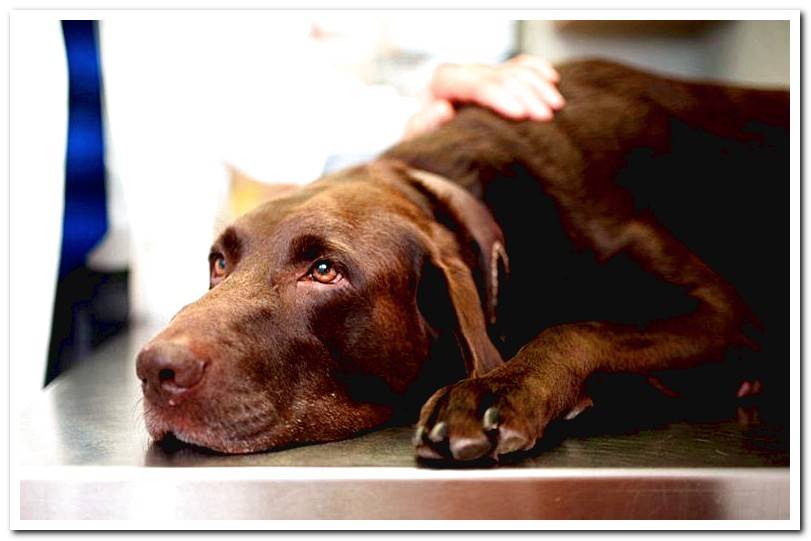
When a dog’s body produces high levels of the hormone cortisol, we may be facing an endocrine disease: Cushing’s Syndrome, also known as hyperadrenocorticism.
In this Dogsis article we will explain what it is, mentioning its most common causes and symptoms, especially in some breeds of dogs more genetically prone to suffering from this dysfunction.
We will also talk about how it is diagnosed and the main treatment for Cushing’s Syndrome. In this way you will be able to better understand how it is fought. You think? Well, let’s start by talking about the causes that cause it.
Index of contents
- 1 Why does Cushing’s Syndrome occur in dogs?
- 2 Symptoms of Cushing’s syndrome in dogs
- 3 Which dogs are more prone to Cushing’s Syndrome?
- 4 Diagnosis and treatment of Cushing’s Syndrome
Why does Cushing’s Syndrome occur in dogs?
As we have already advanced, Cushing’s syndrome in dogs cortisol is related, a hormone that, in adequate levels, helps the body to respond well to stress, to balance body weight, and to ensure that the tissues and skin have a good structure.
However, When there is a chronic overproduction of cortisol, the dog’s immune system weakens and that makes you more exposed to infections and diseases. In addition, it can cause damage to some organs, compromising the dog’s health.
The causes of Cushing’s Syndrome can be several, although three main reasons can be distinguished:
- The malfunction of the pituitary gland, which is what regulates the activity of most endocrine glands.
- Poor functioning of the adrenal glands, where cortisol is produced.
- Reaction to certain medications used to treat other diseases in dogs.
In 80% of cases, according to experts, the most common origin of this dysfunction is a tumor or hypertrophy in the pituitary. It is, therefore, a serious condition and it is important to detect it as soon as possible in order to start treatment.

Symptoms of Cushing’s syndrome in dogs
The most common signs presented by a dog with Cushing’s Syndrome are the following:
- You are thirstier and urinate more frequently.
- You are hungrier than usual
- It can present problems or diseases of the skin
- There are signs of baldness or poor hair quality
- Gasps frequently
- He is tired and down.
- You have muscle weakness or atrophy
- Your belly is swollen
- In females, there may be mismatches in the reproductive cycle
- In males, testicular atrophy may occur
In addition, internally, there are other signs that may indicate that a dog suffers from this syndrome. Despite this, it is often detected by another disease caused by Cushing. Mainly, canine diabetes, hypothyroidism in dogs or other nervous disorders.
Many times visible symptoms are usually attributed to normal aging of the dog, so the syndrome may go unnoticed at first. This can hinder early detection of this condition, which is key for the dog to regain its health.
Normally the symptoms appear little by little and it can take even a few years to show up as a whole, which also makes it difficult for us to realize what is happening. On the other hand, not all dogs respond in the same way to increased cortisol, so symptoms may vary in each case.

Which dogs are more prone to Cushing’s Syndrome?
The dogs that are usually most affected by Cushing’s Syndrome are adult dogs, from 6 years of age, or elderly. In addition, it can also occur in dogs with stress problems.
The fact that a dog is male or female does not seem to influence this hormonal condition. What does matter is the race, as there are some more prone than others.
Teckel, Poodles, Boston Terriers, Small Schauzer, Bichon Maltese and Bobtail may have chronic cortisol excess due to pituitary malfunction.
On the other hand, the origin of Cushing’s Syndrome in Yorkshire terriers, in the Poodle or in the German Shepherd is usually in the adrenal glands. And how can we know for sure if a dog has this condition? Let’s see.
Diagnosis and treatment of Cushing’s Syndrome
For the diagnosis of Cushing’s syndrome in dogs, the veterinaryn must carry out blood tests, urine tests, x-rays, ultrasounds and specific tests to measure cortisol levels. That is, it will take a complete review to find out what happens to our furry friend. In some cases, a CT scan and an MRI will also need to be done.
If the syndrome is confirmed, all these tests will reveal its origin and, based on this, a chronic medication will be prescribed or an operation will be recommended to remove the tumor and thus solve the problems in the glands.
If Cushing’s Syndrome has pharmacological causes, then the medication that is causing the problem will have to be stopped. In any case, it is very important that a dog with this dysfunction go to periodic reviews with the specialist to control its cortisol levels and adjust the medication whenever necessary.
